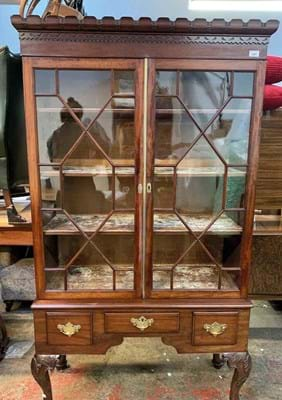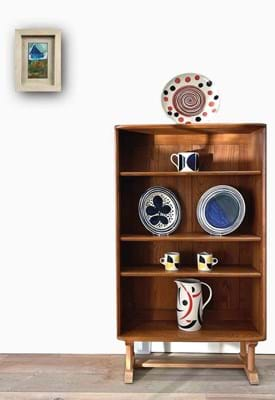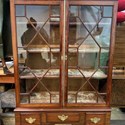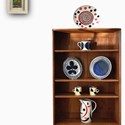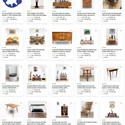Auction bidders keen for a bit of social distancing alongside their paddle waving might be eager to flock to Dawsons in Maidenhead, Berkshire, when the firm opens the doors of its new 12,000 sq ft premises in January.
But they will discover they are in the wrong place. Despite so much space, the firm will be running all its sales online with no room bidding. Put that paddle away: the auction action these days is to be found in the comfort of your own home.
“We went online at the start of the pandemic in March 2020 and have had no room bidding since then,” says managing director Aubrey Dawson. In 2022 he will be broadcasting from a dedicated live streaming room where “everything is geared up for online-only”.
Dawsons is not alone in making major changes to its business as a result of the past two years.
Provincial auction houses around the UK are transforming the way they operate as they seek to meet the expectations of new buyers who are used to the standards set by top internet retailers. Welcome to the always-on auction house.
The inevitable reduction in footfall over the past two years coupled with the rise of online bidding has prompted auctioneers to reconsider what they need to provide to consignors and buyers to be successful.
Internet bidding, though nothing new in itself, has been increasingly attracting new buyers during lockdowns.
“The profile of the buyer is changing,” says Stephan Ludwig, founder of Forum Auctions (now part of Gurr Johns where he is co-chief executive). “As a business we want to attract the Amazon generation. We need to move towards accommodating this buyer’s mentality and attract more of them.”
Here are the key ways auction houses have been adapting in 2021:
Better cataloguing
With viewings off-limits for a while during the pandemic – and now by appointment-only at many venues – auctioneers responded by raising their game in cataloguing.
They have been providing more and better photographs of lots, greater detail in descriptions and more condition reports as standard. This practice continued and even accelerated out of lockdown as it became clear that buyers had become comfortable researching lots from home.
At David Lay Auctioneers in Penzance the furniture photographs for its recent Personal Collection of Jonathan Grimble sale would not have looked out of place in a top high-street store’s catalogue.
“We now have two full-time photographers,” says chairman and owner David Lay. “They are young local people who have studied photography at Falmouth University and are brilliant. They have such great ideas and skills and enable us to do exciting things with new presentations and layouts.”
Ed Crichton, partner in Lacy Scott & Knight’s fine art department, says his Bury St Edmunds firm has also “invested in more staff and more time to photograph items – some lots will get as many as 10 photos or more”.
The rise in remote bidding was a key factor in this decision. “Now about 70-75% of all bids come online while it was 45-50% pre-pandemic,” he says.
In Stansted Mounfitchet, Sworders now employs four full-time photographers and is seeking to recruit more
“Pre-sale we now also provide a comprehensive condition report on every lot we sell,” says chairman Guy Schooling, “Yexue Li, who runs our Asian Art sales, took a minimum of 20 additional photographs for every lot that she offered in her sale; more than one lot had 100 additional images.”
This change has led to fewer viewings at Sworders. Some timed sales and its fortnightly Homes & Interiors sale now have no in-person viewing at all.
“This is a space-driven decision,” says Schooling. “If the auction is not on view to the public, the lots can be stored in more warehouse-like conditions.
“Has it had any affect on auction values? I don’t think so. It comes down to the quality of our images and condition reports.”
Auctioneers have also embraced other technology beyond digital photography to attract and engage bidders.
In addition to outputting a large amount of video content, Dreweatts works with CoreLogic’s Matterport 3D technology to shoot lots inside its premises in Newbury as well as on location such as in country houses. A virtual viewing experience is then created for bidders to review the lots online in a more immersive way.
“Virtual tours engage people and really work for home and interior scenic shots,” says managing director Jonathan Pratt. “We are always looking at technology and continue to develop new ideas.”
Online bidders come first
Another area where auction houses have been kitting themselves out with technology is on the rostrum itself.
With fewer or no people in the room on sale day, an auctioneer’s performance now has to prioritise remote bidders first. Ensuring the saleroom – and the auctioneer – is fit for this purpose has become increasingly important.
“Auctioneering has changed in that we now focus entirely on two or three tiny webcams,” says Schooling. “Very few people attend on auction day, for reasons I quite understand. I think this is a fundamental change that will not be reversed.
“Therefore, we are now thinking much more carefully about our online presentation, including auction day and the appearance of the auctioneer on the rostrum.
“We are in the process of re-designing our rostrum, specifically to make it more camera-friendly, and we are encouraging our auctioneers to wear brighter-coloured clothing.”
When Edinburgh auction house Lyon & Turnbull re-opened its premises for room bidding this year, it found so few people turned up that it was effectively operating its sales as live online-only events.
For its Lowood House auction in October, for example – which in times past would have attracted a capacity crowd – just six bidders were in the room with the rest online or on the phone.
No matter, L&T has still enjoyed its best-ever year, recording a hammer total of more than £21m (and that excludes the items sold in partnership with Freeman’s in Philadelphia). Pre-pandemic, it reported sales of £11.5m in 2019.
Managing director Gavin Strang says: “Where previously it was ‘on-stage’ theatre, it is now livestreaming, and the audience has expanded massively. I think that online bidding has been seen as more accessible by a new generation who may have never considered entering a physical auction house before.
“Our auctioneers now have to learn to play to the camera rather than the room. Everything is geared around helping a remote audience feel comfortable about bidding.”
The investment in technology to get it right does not come cheap. Dawsons is spending £500,000 on its new premises, as Aubrey Dawson explains:
“The dedicated live streaming room for online auctions has great acoustics, the right lighting, a very good camera and high-speed internet. We have made an investment in all the best technology to make this work extremely well.”
New sales calendars
Auction houses have also taken steps to accommodate new buyers’ and consignors’ expectations by shaking up their auction calendars.
Put simply, nobody wants to wait months – or even weeks – for the next sale to come along. Speeding up the auction cycle with online sales and thereby attracting more consignors makes an auction house more profitable.
“In last 12 months we have held 31 auctions, compared with 14 a year previously,” says Dawson. “Our calendar is much more flexible. We are not held to a printed catalogue deadline and we don’t have the delays of setting up rooms for room bidding. This means vendors can receive their money more quickly.
“We had a client come to us who had been told by another firm that he would have to wait seven months for the sale and then payment after that, so he came to us as we can turn things around much more rapidly.”
At Richard Winterton in Lichfield a combination of sales with fewer lots and a rise in timed sales is working well. “We used to worry that we had to have large sales but we don’t need to do that; a 150-lot sale is fine,” says director Richard Winterton. “We have introduced a few more sales and we work with Auction Technology Group on how to do targeted marketing to bidders for them.
“We have also increased the number of timed online sales and that is another focus for us. We are planning timed sales of coins, wine and more.”
More timed auctions
The use of timed auctions has been growing rapidly over the past two years.
Auction Technology Group (owner of thesaleroom.com and Antiques Trade Gazette) reported that the total hammer value transacted in live online only or timed online auctions on its marketplaces has increased by 44.8% year-on-year.
At Dreweatts, which held 25 timed sales this year on thesaleroom.com compared with 13 last year, Pratt says his firm will focus on lots between £500-2000 which are “much easier to sell online and consignors are happy with that” and it will avoid timed sales of much lower-value items.
The same principles of good cataloguing and offering fresh stock apply to timed auctions just as they do to live events.
Firms hoping to offload unsold items via timed sales tend to fare less well with the sell-through whereas well-curated timed auctions have no problem attracting buyers, many of whom who are younger and familiar with the format due to eBay.
A regular roster of timed sales ensures an auction house is always in the market with something to offer. This provides fuel for marketing activity, content for social media and helps to raise a firm’s standing in search engine optimisation – the always-on approach.
In specialist categories well-managed timed sales can be used for the bulk of a firm’s annual calendar with the live format reserved for fine sales.
“Consignors love the immediacy and regularity of the timed sales,” says Ludwig. “At Forum this year we did 60 auctions: 18 live and the rest timed. This was our business model already. Our timed sales have a 98% sell-through rate. They are an exceedingly effective selling format; it doesn’t compromise vendors and the buyers like them.”
Watches and jewellery specialist Fellows in Birmingham runs a roster with a similar split: it held 75 specialist auctions this year, 64 of which were timed and 11 were live. In the latter part of this year it also introduced weekly timed jewellery auctions.
At 1818 Auctioneers in Cumbria no live sales were held at all. Instead it ran more than 150 timed auctions.
Fewer printed catalogues
While they increase the number of sales, auction houses have been reducing their output of printed material. The December sales at Lacy Scott & Knight were the last to be accompanied by a heavy, glossy catalogue.
“We will move to a digital catalogue alongside a slimmed-down printed brochure which will be given to viewers on preview days and to a select few who request it,” says LSK’s Crichton. “We will reduce our mailing list by 90%. We have agonised over it but we feel it is the right way to go.”
Dawsons and Richard Winterton have also halted printed catalogues. Other firms are printing fewer but have not stopped completely. The Society of Fine Art Auctioneers, for example, expects its members to produce a printed edition for its specialist sales.
“People want a record of sale for the fine and collection auctions,” says Pratt at Dreweatts, “and so a printed catalogue is needed but mid-season sales do not require catalogues and we are marketing those differently online.”
At Sworders the jury is still out. “I am torn on this,” admits Schooling. “They are expensive but the more others decide to cut them, the longer I am minded to retain them as a point of difference.
“However, we do not produce printed catalogues for timed sales and will not produce a formal printed catalogue for our Asian Art sales. With the latter, most of the buyers are in the Far East and never see a printed catalogue.”
After-sales service
Some auction houses might not be sending out printed catalogues any more but many are raising their game when it comes to packing and delivering items from their sales.
“We now have teams of dedicated staff for after-sales service,” says Richard Winterton. “This is a big deal for us. Our focus for next year is growing the posting and packaging service and improving it. Buyers expect great service but wrapping and sending a 100-piece tea set is very time consuming and costly to pack.
“You can improve the service by being honest with the buyer about the cost and when to expect the item.”
Sworders set up a delivery service during lockdown and Dreweatts has plans to establish one. Fellows in Birmingham, which has long offered a best-in-class packing and delivery service, has been extending its free delivery offering – exactly what the Amazon generation of buyer has come to expect from online services.
“Many bidders will bid on a Wednesday and receive the item by Friday and we have made our offer of free worldwide postage standard on about 90% of the pieces we sell,” says Alexandra Whittaker, the firm’s PR and communications manager.
“Along with our high level of customer service and ease of payment, it is the most remarked on feature in our online reviews.”
Online engagement
Those online reviews are increasingly important for all auctioneers. Managing your reputation these days is very much a digital affair. A potential customer searching for your business will see online review scores and comments before they even reach your website.
Fellows’ impressive score on Trustpilot of 4.7 out of 5 reflects its emphasis on after-sales service and it responds to every review posted.
“We also offer an online chat function,” says Whittaker. “As we encourage communication at all stages of consignment or buying, most issues can be resolved before a review is left. However, when we do get a bad review, or make a mistake (we are only human after all) we are quick to own our mistakes and find a solution.”
Dawsons also uses online chat on its website. “We have a team of call handlers operating Monday-Friday during business hours,” says Aubrey Dawson. “Outside business hours we can take a message and get back to them the next working day. We have been winning business this way.”
Social media is similarly important, both for managing reputation and finding new customers.
“Our business is more focused on digital than ever before and we have recently adopted a TikTok channel,” says Whittaker. “It’s another chance for us to reach a new audience. It has been successful so far for us with a couple of our posts going viral. One has over 890,000 views.”
More staff
With so much more to manage – more sales, more photographs, more condition reports, packing, delivery, technology, online reputation and outreach – it is little wonder auction houses have been busily increasing their staff numbers.
“We’ve recruited enormously in last two years,” says David Lay. “There are now about 20 people here with new recruits in packaging, photography and cataloguing and we propose to carry on growing.
“Who would have thought three years ago we would have had all these changes? I have old clients coming to me in awe. It is so much slicker now.”



